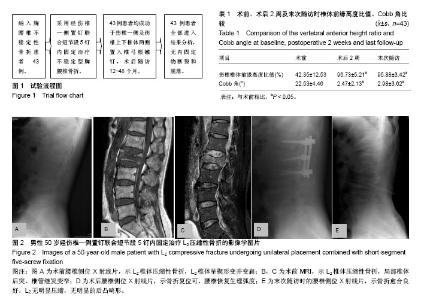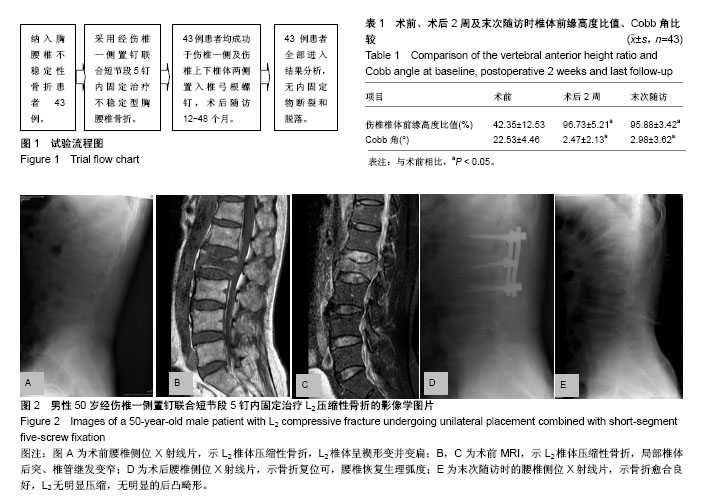| [1] Defino HL, Herrero CFP, Romeiro CF. Monosegmental fixation for the treatment of fractures of the thoracolumbar spine. Indian J Orthop. 2007;41(4):337-345.[2] Baaj AA, Reyes PM, Yaqoobi AS, et al. Biomechanical advantage of the index-level pedicle screw in unstable thoracolumbar junction fractures. J Neurosurg Spine. 2011; 14(2):192-197.[3] Wang HW, Li CQ, Zhou Y, et al. Percutaneous pedicle screw fixation through the pedicle of fractured vertebra in the treatment of type A thoracolumbar fractures using Sextant system: an analysis of 38 cases. Chin J Traumatol. 2010; 13(3):137-145.[4] 鱼红进,刘兴国,王振汉,等. 经伤椎椎弓根固定不植骨治疗不稳定型胸腰椎骨折[J]. 创伤外科杂志, 2015,17(3):214-216.[5] 曾忠友,张建乔,金才益,等. 经伤椎置钉椎弓根螺钉系统固定治疗胸腰椎骨折2年以上随访结果[J]. 中国骨伤, 2012, 25(2): 128-132.[6] Magerl F, Aebi M, Gertzbein SD, et al. A comprehensive classification ofthoracic and lumbar injuries. Eur Spine J. 1994;3(4): 184-201.[7] 谢炜星,王刚,万超,等. 短节段伤椎置钉椎弓根螺钉固定治疗 Magerl A 型胸腰椎骨折的效果[J]. 广东医学, 2016, 37(16): 2448-2451.[8] Lazaro BC, Deniz FE, Brasiliense LB, et al. Biomechanics of thoracic short versus long fixation after 3-column injury. J Neurosurg Spine. 2011;14(2):226-234. [9] Alpantaki K, Bano A, Pasku D, et al. Thoracolumbar burst fractures: a systematic review of management. Orthopedics. 2010;33(33):422-429.[10] Eno JJT, Chen JL, Mitsunaga MM. Short same-segment fixation of thoracolumbar burst fractures. Hawaii J Med Public Health. 2012;71(1):19-22. [11] 刘传安,程黎明. 胸腰椎爆裂骨折的手术治疗进展[J]. 中华外科杂志, 2009, 47(12):947-949.[12] Tezeren G, Kuru I. Posterior fixation of thoracolumbar burst fracture: short-segment pedicle fixation versus long-segment instrumentation. Clin Spine Surg. 2005;18(6):485.[13] 曾至立,程黎明,钱列,等. 单侧伤椎置钉联合短节段椎弓根螺钉内固定治疗轻中度不稳定性胸腰椎骨折[J]. 中华外科杂志, 2012,50(3):234-237.[14] 郑晓勇,侯树勋,李利,等. 经伤椎椎弓根椎体内植骨结合椎弓根螺钉内固定治疗胸腰椎爆裂骨折的长期疗效观察[J]. 创伤外科杂志, 2009,11(6):484-487.[15] 徐荣明,吕亮.胸腰椎骨折治疗的热点问题探讨[J].中华创伤杂志, 2017,33(3):193-196.[16] 赵杰,田海军.胸腰椎骨折诊治中存在的争议问题[J].中华创伤杂志,2017,33(7):581-584.[17] 俞阳,范海泉,陈铭,等. 经伤椎和跨伤椎椎弓根钉棒系统内固定治疗胸腰椎骨折[J]. 脊柱外科杂志, 2012, 10(4):228-231.[18] 袁强,田伟,张贵林,等. 骨折椎垂直应力螺钉在胸腰椎骨折中的应用[J]. 中华骨科杂志,2006,26(4):217-222.[19] Dick JC, Jones MP, Zdeblick TA, et al. A biomechanical comparison evaluating the use of intermediate screws and cross-linkage in lumbar pedicle fixation. J Spinal Disorders. 1994;7(5):402-407.[20] Norton RP, Milne EL, Kaimrajh DN, et al. Biomechanical analysis of four-versus six-screw constructs for short-segment pedicle screw and rod instrumentation of unstable thoracolumbar fractures. Spine J. 2014;14(8):1734-1739.[21] 陈艺,白波,孙辉,等. 短节段椎弓根钉固定术的生物力学研究[J]. 中华创伤杂志, 2010, 26(1):39-43.[22] 陈农,周海林,周凯华,等. 伤椎固定及经伤椎椎弓根椎体内植骨治疗胸腰段骨折[J]. 中国矫形外科杂志, 2016, 24(6):525-530.[23] 曾金才,朱立帆,朱晓东,等. 经伤椎单、双侧置钉内固定治疗胸腰椎骨折的疗效[J]. 临床骨科杂志, 2016, 19(3):283-286. |

